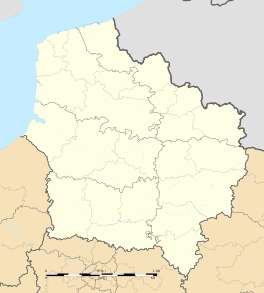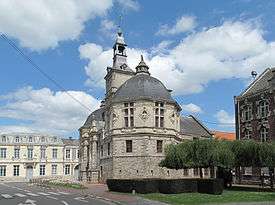Saint-Amand-les-Eaux
| Saint-Amand-les-Eaux | ||
|---|---|---|
| ||
 Saint-Amand-les-Eaux | ||
|
Location within Hauts-de-France region  Saint-Amand-les-Eaux | ||
| Coordinates: 50°26′55″N 3°25′41″E / 50.4486°N 3.4281°ECoordinates: 50°26′55″N 3°25′41″E / 50.4486°N 3.4281°E | ||
| Country | France | |
| Region | Hauts-de-France | |
| Department | Nord | |
| Arrondissement | Valenciennes | |
| Canton | 2 cantons | |
| Intercommunality | Porte du Hainaut | |
| Government | ||
| • Mayor (2001–2008) | Alain Bocquet | |
| Area1 | 33.81 km2 (13.05 sq mi) | |
| Population (2006)2 | 16,777 | |
| • Density | 500/km2 (1,300/sq mi) | |
| Time zone | CET (UTC+1) | |
| • Summer (DST) | CEST (UTC+2) | |
| INSEE/Postal code | 59526 / 59230 | |
| Elevation |
14–39 m (46–128 ft) (avg. 17 m or 56 ft) | |
|
1 French Land Register data, which excludes lakes, ponds, glaciers > 1 km² (0.386 sq mi or 247 acres) and river estuaries. 2 Population without double counting: residents of multiple communes (e.g., students and military personnel) only counted once. | ||

Saint-Amand-les-Eaux (French pronunciation: [sɛ̃.ta.mɑ̃.lɛ.z‿o] ; Flemish: Sint-Amands-aan-de-Skarpe) is a commune in the Nord department in northern France on the Scarpe river. The town people are named Amandinois (men), Amandinoise (Women).
Saint-Amand Abbey, formerly Elnon or Elnone Abbey, was located here from its foundation in the 630s by Saint Amand until its dissolution in 1789.
Heraldry
.svg.png) |
The arms of Saint-Amand-les-Eaux are blazoned : Vert, a sword argent hilted Or between 2 fleurs de lys Or. |
Local Places and Attractions
Industries
Saint Amand has an industrial belt, casino, shopping centre, thermal baths, and several springs.
The Tower
A tower on the plaza standing 82 metres tall is the symbol of this town. It is part of a large ancient abbey, and it was the enter with the Echevinage next to. It has a carillon with 48 bells and a museum devoted to faience. It was founded in the 7th century by a friar named Amand, reconstructed by abbot Nicolas Dubois, a masterful and proud person. Declared national property at the French Revolution in 1789, destroyed in 1794. The tower is ornamented with statues, some of which were defaced in 1789. But we can see the Lothaire's statue founder of the Saint Amand school in 9th century in north face. The Saint Amand, Saint Denis, Saint Benoist and Saint Martin's statues on fifth level south face. On south face, third level, we can see the Saint Juliette and Saint Cyr's statues. On fifth level, the Hucbald 's statue which was a poet and musician, and we can see dragons symbolizing the evil spirit tamed by Saint Amand
The carillon
The clock with roller and the carillon have been constructed in 1640, but the ancient abbey was had many bells, too, of which the friar d'Elnon and Giselberg deplore, in a poem, the loss of 17 bells in a fire in 1066. Jehan Froissart, in this chronicles relate the siege of Saint Amand in 1340 and bells war damaged. In 1784-1785, G.L.Barbieux, one fonders of Tournai, smelted bells down below the tour. The carillon ring the bell at half past eleven to twelve o'clock, since February 18, 1802 ( 15 pluviose, fifth year ) each days to warn the workers than the lunch approach.
The Echevinage
Named priory too, because it was touched the prior's rooms, built in 1632 during the Flemish Renaissance, was the primary front door of abbey. There was magistrate of the town's meeting rooms. In second level there was justice room and jails in street level. One moat, named "Madame" was facing the front door which had drawbridge and portcullis. The bell, named bancloque[1] was called the people so that they hear the magistrate's speeches than he was screamed on his balcony at the top of the front door. Till then 1958, in the firth level, the peace justice was done. In this level there was wedding room, burned in 1949, rebuilt after. In second level there are echevinal and reception rooms, and the Watteau room where there are paintings painted by himself in 1781 and 1792.
Saint Martin's church
On the place of the actual church there was a Saint Martin's Mont des Cornet, at the 7th century and romance church in 11th century
The ancient faience factories
Saint Amand is known for its faience, produced, in the past, by ancient faience factories who was used the bianco sopra bianco technical.
- 1705 Nicolas Demoutier built a faience factory, managed by himself and by the family Dorez, descendants of Bartélémy a ceramist from Lille, in the next place. The faience factory equipment was sold to Bécart in 1775, who has been installed this firm in Valenciennes.
- 1718, the Fauquez family built their faience factory. They were natives of Tournai in Belgium. The roads, waterways and forests were favourable for transporting the products, so they set up their firm in Saint Amand. But the Treaty of Utrecht, which set the frontier between Tournai and Saint Amand forbade the transport of faience across the border. The faience was hidden in kegs and hay to cross the frontier. The Fauquez's factory was closed in 1794.
Sister cities
See also
References
- ↑ bancloque is the French writing of the Dutch/Flemish word banklokke. A banklokke (i.e. public announcement bell) was used by local authorities to gather people for announcements. (Cf. Van begin 14de tot begin 15de eeuw deed de klok dienst als banklokke, waarbij ban bekendmaking betekent. from: klokke-roeland.nl)
| Wikimedia Commons has media related to Saint-Amand-les-Eaux. |